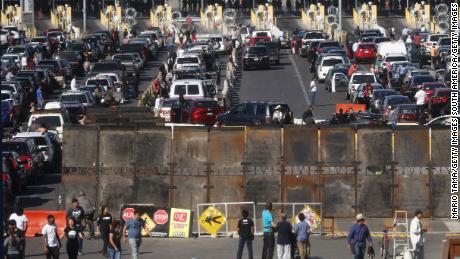
The policy, informally known as “Remain in Mexico,” has drawn the ire of immigration advocates and lawyers who argue that it puts migrants who are predominantly from Northern Triangle countries and seeking asylum in the US in harm’s way.
The three-judge panel — made up of two judges appointed by Democratic presidents and one appointed by a Republican — grappled with whether the policy should be allowed to continue, diving into technical matters and raising concerns about the process itself without providing much indication about where they stood overall.
Judge Paul J. Watford, for example, expressed skepticism over not asking asylum seekers whether they fear returning to Mexico.
“I don’t understand how the government is taking the view that you don’t have to ask the person who is to be returned whether they have a fear of being returned to Mexico,” Watford said. “I just don’t see how that is not arbitrary and capricious.”
Earlier this month, Judge Richard Seeborg of the Northern District of California blocked the policy. His reasoning was that the provision on which the government was relying was never intended to permit the return of asylum seekers to Mexico, and even if it did, the current screening procedures were not adequate, said Melissa Crow, senior supervising attorney at the Southern Poverty Law Center.
put the order on hold, allowing the policy to temporarily continue.
The so-called Migrant Protection Protocols program was initially rolled out at the San Ysidro port of entry in January. It’s since expanded to include Calexico port of entry, San Diego sector, Paso del Norte port of entry, El Paso sector and El Centro sector, according to the Department of Homeland Security.
The administration has argued that the policy is aimed at stemming the flow of migrants, but a number of issues have cropped up at the proceedings for migrants who fall under the policy.
During immigration hearings last month, migrants expressed a fear of returning to Mexico and explained the difficulties they faced in obtaining legal representation while in another country. Immigration lawyers also struggled to navigate the policy, which presented a new host of challenges, like communicating with clients residing in another country.
This latest challenge on an administration policy stems from a coalition of immigrant advocacy groups who asked a federal judge for a restraining order that would block the policy. Eleven migrants who are seeking asylum in the United States and were returned to Mexico under the policy are also plaintiffs in the case.
Trump, for his part, has fumed over the legal challenges that have kept his administration from implementing a series of controversial policies. It’s almost become so common that Trump publicly griped about the challenges his national emergency declaration would face.
“We will have a national emergency and we will then be sued,” Trump said in the Rose Garden in February. “We’ll possibly get a bad ruling, and then we’ll get another bad ruling, and then we’ll end up at the Supreme Court and hopefully we’ll get a fair shake.”
A judge also blocked the administration’s “zero tolerance” immigration policy that resulted in the separation of parents and children.

